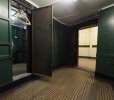Mike W
Western Thunderer
I agree. like these, made locally to me.A s.w.a.g. following a clue in the larger scale thread - shaft bores (stairs/lift) to connect to the tube station? The sections to represent the cast-iron shaft lining.
I agree. like these, made locally to me.A s.w.a.g. following a clue in the larger scale thread - shaft bores (stairs/lift) to connect to the tube station? The sections to represent the cast-iron shaft lining.
The side of the stairwell will have a window cut into it so that the spiral stairs can be seen, Michael. These will be 3D printed by Richard Wilson, but he is currently engaged with sorting out the tube at the north end, at Caledonian Road.A very neat Idea, and can one actually see the top of the stairs? asking for a friend.
Michael


Brilliant stuff as usual. I’m intrigued by the work holder in the tailstock - what is it?2mm fine scale modelling, but of what?
It’s an Albrecht chuck, Chris, with the brass tube supported on it’s outside. The work was only turned by hand (I now have a lathe handle on my birthday present list).Brilliant stuff as usual. I’m intrigued by the work holder in the tailstock - what is it?
By coincidence I also keep my Rocol and some lathe tools in an identical ice cream tub, but I suspect that’s where the similarity between workshops ends…




This team member thinks that you've posted the wrong photo 3!What does the team think?
In clay, ugly lumpen surface with rust nodules. Mostly dark brown with bright orange to yellow rust blobs once the clay is washed off.It’s all a bit of a quandary, really. The iron may be in an anaerobic atmosphere within the clay so would probably not rust much. Equally it would be below the water table for some of the depth (Gasworks is a very wet tunnel). There could be water channels around the shafts.
What colour are cast iron pipes when they’re dug up?
Tim





